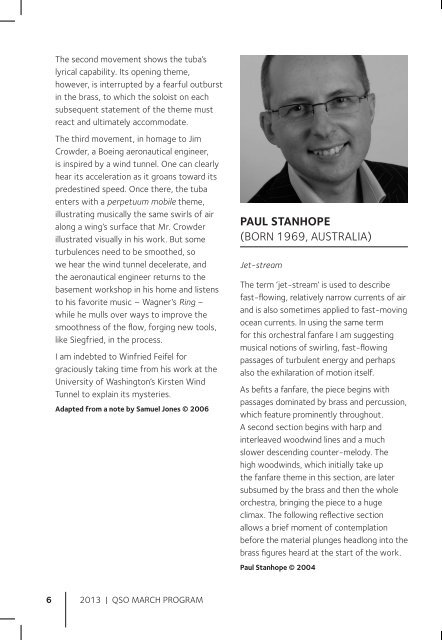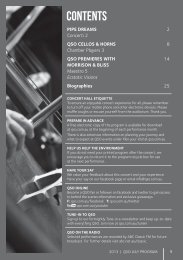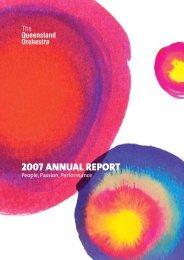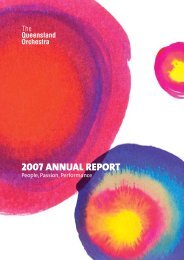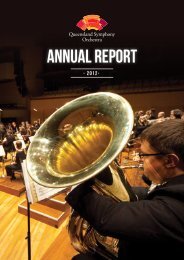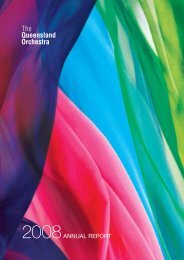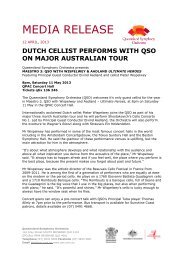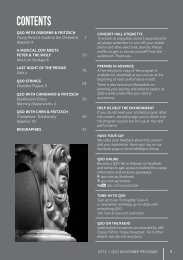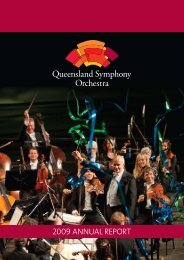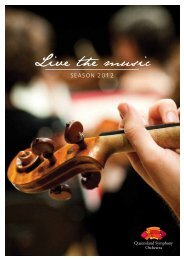March 2013 - Queensland Symphony Orchestra
March 2013 - Queensland Symphony Orchestra
March 2013 - Queensland Symphony Orchestra
Create successful ePaper yourself
Turn your PDF publications into a flip-book with our unique Google optimized e-Paper software.
The second movement shows the tuba’s<br />
lyrical capability. Its opening theme,<br />
however, is interrupted by a fearful outburst<br />
in the brass, to which the soloist on each<br />
subsequent statement of the theme must<br />
react and ultimately accommodate.<br />
The third movement, in homage to Jim<br />
Crowder, a Boeing aeronautical engineer,<br />
is inspired by a wind tunnel. One can clearly<br />
hear its acceleration as it groans toward its<br />
predestined speed. Once there, the tuba<br />
enters with a perpetuum mobile theme,<br />
illustrating musically the same swirls of air<br />
along a wing’s surface that Mr. Crowder<br />
illustrated visually in his work. But some<br />
turbulences need to be smoothed, so<br />
we hear the wind tunnel decelerate, and<br />
the aeronautical engineer returns to the<br />
basement workshop in his home and listens<br />
to his favorite music – Wagner’s Ring –<br />
while he mulls over ways to improve the<br />
smoothness of the flow, forging new tools,<br />
like Siegfried, in the process.<br />
I am indebted to Winfried Feifel for<br />
graciously taking time from his work at the<br />
University of Washington’s Kirsten Wind<br />
Tunnel to explain its mysteries.<br />
Adapted from a note by Samuel Jones © 2006<br />
PAUL STANHOPE<br />
(BORN 1969, AUSTRALIA)<br />
Jet-stream<br />
The term ‘jet-stream’ is used to describe<br />
fast-flowing, relatively narrow currents of air<br />
and is also sometimes applied to fast-moving<br />
ocean currents. In using the same term<br />
for this orchestral fanfare I am suggesting<br />
musical notions of swirling, fast-flowing<br />
passages of turbulent energy and perhaps<br />
also the exhilaration of motion itself.<br />
As befits a fanfare, the piece begins with<br />
passages dominated by brass and percussion,<br />
which feature prominently throughout.<br />
A second section begins with harp and<br />
interleaved woodwind lines and a much<br />
slower descending counter-melody. The<br />
high woodwinds, which initially take up<br />
the fanfare theme in this section, are later<br />
subsumed by the brass and then the whole<br />
orchestra, bringing the piece to a huge<br />
climax. The following reflective section<br />
allows a brief moment of contemplation<br />
before the material plunges headlong into the<br />
brass figures heard at the start of the work.<br />
Paul Stanhope © 2004<br />
SIEGFRIED MATTHUS<br />
(BORN 1934, GERMANY)<br />
Timpani Concerto Der Wald<br />
In three movements<br />
Tim Corkeron, Timpani<br />
I am rapt to be doing this piece…It tells a<br />
story and explores the more subtle sounds<br />
that timpani can make. The accompanying<br />
orchestral colours and interjections are well<br />
crafted by Matthus.<br />
Tim Corkeron<br />
Siegfried Matthus is a composer notable<br />
for the broad spectrum of his musical<br />
output. Apart from writing works for the<br />
stage he has given special attention to<br />
pieces for solo voices and instruments<br />
over the past twenty years or so. Unusual<br />
combinations are an intriguing feature, as<br />
in the Concerto for Timpani and <strong>Orchestra</strong><br />
Der Wald (‘The Forest’) dating from<br />
1984. Commissioned by the Dresden<br />
Staatskapelle, it was intended for the<br />
orchestra’s principal timpanist, Peter<br />
Sondermann. As the title of the concerto<br />
indicates, this is a musical discourse on our<br />
dying forests – a taboo subject in what was<br />
the Germany Democratic Republic. By way<br />
of introduction the score contains a passage<br />
from Hölderlin’s Hyperion: ‘O tree of life,<br />
if only I could turn green with you again<br />
and share the fragrance of your canopy<br />
and all your budding twigs, peaceably and<br />
fervently, for we all have grown out of the<br />
same golden seed.’ The concerto comprises<br />
three movements played without a break,<br />
the orchestra consisting only of brass, harp<br />
and strings. The relationship between the<br />
soloist and the various orchestral sections<br />
is marked by ‘growing mutual affection’<br />
rather than ‘adversity’. The first movement,<br />
proceeding largely at a gentle, unhurried<br />
pace, recalls a romantic forest in its<br />
evocative texture. In the second movement,<br />
images of its destruction in modern times<br />
call forth expressions of grief and mourning.<br />
This contrasts sharply with the mood of the<br />
final movement in which the soloist moves<br />
into action in a forceful cadenza. The whole<br />
orchestra rallies behind him in the furious<br />
finale, which ends on a note of passionate<br />
resolve and protest.<br />
Frank Schneider, Breitkopf & Härtel © 1991<br />
6 <strong>2013</strong> | QSO MARCH PROGRAM<br />
<strong>2013</strong> | QSO MARCH PROGRAM 7


